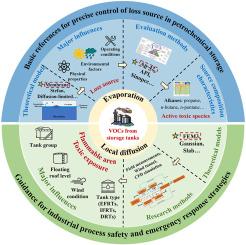A systematic literature review on the evaporation loss mechanisms and local diffusion characteristics of volatile organic compounds (VOCs) from petrochemical storage tanks
IF 4.2
3区 工程技术
Q2 ENGINEERING, CHEMICAL
Journal of Loss Prevention in The Process Industries
Pub Date : 2025-09-16
DOI:10.1016/j.jlp.2025.105801
引用次数: 0
Abstract
Hazardous VOCs evaporated from petrochemical storage tanks pose an immediate threat to process safety and environmental health, which has attracted increasing emphasis. Even though a series of source suppression and process safety strategies have been recently implemented to mitigate potential hazards, the practical effectiveness is subject to uncertainties due to the unclear loss and transfer mechanisms, thereby limiting the accurate identification of options and optimizations. Despite its significance, there still lacks a thorough summary of evaporation mechanisms and local diffusion characteristics of VOCs from storage tanks. To further promote loss prevention in the petrochemical storage process, this paper focuses on the relevant literature from multiple perspectives: theoretical models, research methods, major influences, loss evaluation methods, and associated safety concerns. The advantages and limitations of theoretical models and research methods are discussed. The evaporation mechanisms in storage tanks under various major influences are analyzed, and the evaluation methods of evaporation loss are illustrated. The source composition characteristics and active toxic species of evaporated VOCs are identified. The local diffusion characteristics of VOCs from EFRTs, IFRTs and DRTs, dynamic variations with wind and obstacle conditions, and associated flammable and toxic risks are overviewed, respectively. Furthermore, the existing challenges and future research directions are proposed accordingly. This study aims to provide valuable reference and implications for loss prevention and emergency response strategies in the petrochemical storage process.

对石油化工储罐挥发性有机物(VOCs)的蒸发损失机理和局部扩散特性进行了系统的文献综述
石油化工储罐挥发出的有害挥发性有机化合物对过程安全和环境健康构成直接威胁,已日益引起人们的重视。尽管最近已经实施了一系列源抑制和过程安全策略来减轻潜在危害,但由于损失和转移机制不明确,实际有效性受到不确定性的影响,从而限制了选择和优化的准确识别。尽管具有重要意义,但对储罐挥发性有机化合物的蒸发机理和局部扩散特征仍缺乏深入的总结。为进一步推进石油化工储存过程的防损工作,本文从理论模型、研究方法、主要影响因素、损失评估方法以及相关安全问题等多个角度对相关文献进行了梳理。讨论了理论模型和研究方法的优缺点。分析了储罐在各种主要影响下的蒸发机理,阐述了蒸发损失的评估方法。确定了蒸发挥发性有机化合物的来源组成特征和活性毒性种类。综述了EFRTs、ifrt和DRTs VOCs的局部扩散特征、风和障碍物条件下的动态变化以及相关的可燃和毒性风险。在此基础上,提出了存在的挑战和未来的研究方向。本研究旨在为石油化工储存过程中的损失预防和应急响应策略提供有价值的参考和启示。
本文章由计算机程序翻译,如有差异,请以英文原文为准。
求助全文
约1分钟内获得全文
求助全文
来源期刊
CiteScore
7.20
自引率
14.30%
发文量
226
审稿时长
52 days
期刊介绍:
The broad scope of the journal is process safety. Process safety is defined as the prevention and mitigation of process-related injuries and damage arising from process incidents involving fire, explosion and toxic release. Such undesired events occur in the process industries during the use, storage, manufacture, handling, and transportation of highly hazardous chemicals.

 求助内容:
求助内容: 应助结果提醒方式:
应助结果提醒方式:


